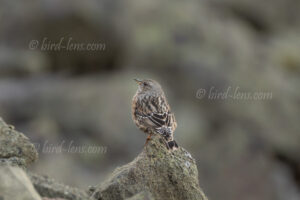 We actually see the first Alpine Accentor (Prunella collaris) at the summit of Sněžka, the highest peak in the Krkonoše, or Karkonosze – Moutains, which are also called „Giant Mountains“. As we were just leaving the plateau we see 9-12 individuals of this species calling and flying around the houses in the immediate vicinity of the houses there and then landing somewhere in the scree. Later I see more Alpine Accentors. Some hop around on the roof of a building, others search the ground for food. The loose plumage, lowered wings and tucked head give these birds a rather clumsy appearance. One is tempted to think of young Common Starlings (Sturnus vulgaris). Then an Alpine Accentor takes a seat on a boulder as I sit on the side of the path – everything is cordoned off beyond the paved paths – and look for the Water Pipits (Anthus spinoletta). The Alpine Accentors often let out their lark-like call. Later the Alpine Accentors disperse and we meet them again in the jagged rocks on the southwestern slope of Sněžka.
We actually see the first Alpine Accentor (Prunella collaris) at the summit of Sněžka, the highest peak in the Krkonoše, or Karkonosze – Moutains, which are also called „Giant Mountains“. As we were just leaving the plateau we see 9-12 individuals of this species calling and flying around the houses in the immediate vicinity of the houses there and then landing somewhere in the scree. Later I see more Alpine Accentors. Some hop around on the roof of a building, others search the ground for food. The loose plumage, lowered wings and tucked head give these birds a rather clumsy appearance. One is tempted to think of young Common Starlings (Sturnus vulgaris). Then an Alpine Accentor takes a seat on a boulder as I sit on the side of the path – everything is cordoned off beyond the paved paths – and look for the Water Pipits (Anthus spinoletta). The Alpine Accentors often let out their lark-like call. Later the Alpine Accentors disperse and we meet them again in the jagged rocks on the southwestern slope of Sněžka.
The Alpine Accentor is the bird species most native to the high mountains among the birds of the Giant Mountains. It is very rare in Poland – it only occurs in the highest mountain ranges from the Tatra Mountains to the Giant Mountains. The largest population of the Alpine Accentors is located in the Tatra Mountains, where their breeding areas reach up to 2,250 m above sea level. Breeds of this species have also been observed in isolated cases in the Sněžka massif. Polish populations of the Alpine Accentor in the Sudetes and Carpathians are the northernmost locations in Europe. The species’ distribution area includes the mountains of Eurasia and North Africa. The Alpine Accentor is easiest to observe near the Sněżka and the adjacent Śnieżne Kotły (Czech: Sněžné jámy). The Alpine Accentor is a grayish-colored bird the size of a Sparrow, with rust-colored flight feathers, rust-red breast and sides, and an ash-gray head. Characteristic features of the Alpine Accentor are: a light neck with rows of dark spots, wing stripes of white dots and a yellow base of the lower beak. The Alpine Accentor’s main food is seeds and small invertebrates such as insects, snails and spiders. It is a bird that withstands the difficult conditions of a harsh mountain winter very well. It does not fly away in the fall, but after the breeding season it moves to places where food is more readily available. It then feeds between spruce branches or near shelters, using the remains left behind by humans. As soon as the snow subsides, the Alpine Accentors begin breeding. The song of the Alpine Accentor consists of varied tones, some of its fragments are similar to the song of the well-known Skylark. The enticing calls are associated with the chirping of a sparrow. The Alpine Accentor nests between rocks, in crevices, under rocks or in depressions under the vegetation cover. To build them, they use material available in the area – roots, moss, blades of grass, etc. Most often, the parents produce two broods in one breeding season. The Alpine Accentor is a strictly protected species and is listed on the Polish Red List.
But there are other “exotics” in the Giant Mountains. The northern subspecies of the Bluethroat (Luscinia svecica svecica) nests in the subalpine peat bogs of the Giant Mountains.
To meet the growing demand for top-of-the-line images of the rarer Palaearctic species, Bird-lens.com strives to expand the range of images of Western Palaearctic birds. Trips to many locations to take pictures of rare western Palearctic birds have been very successful. This nice picture of the blog is just a first impression of what you can find in the gallery of the “Picture Shop” very soon. Please leave a message if bird-lens.com can provide a picture.